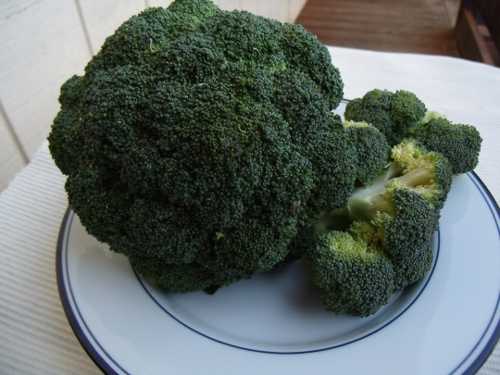- Lake County News Reports
- Posted On
The Veggie Girl: Broccoli banter

I may have kept this a secret until now, but my husband and I have a mixed marriage. Yes, a dividing line exists between us regarding a very important subject.
He’s a broccoli hater. I happen to think it’s one of the most incredible foods on the planet.
How can someone hate this amazing vegetable, I wonder? But many do.
Broccoli seems to evoke strong emotions. I don’t recall encountering anyone who, when the subject arose, didn’t have a vigorous opinion. While broccoli haters exist, this verdure also has its ardent followers, including me.
Even the elder President Bush got into the act. He famously said, “I do not like broccoli. I haven’t liked it since I was a little kid and my mother made me eat it. I’m president of the United States and I’m not going to eat any more broccoli!”
The truth is that broccoli is a nutritional powerhouse and remains a regular on every super foods list I’ve seen.
It’s a versatile vegetable that’s favored in pasta dishes, cream soups, casseroles and stir-fries. When steamed or boiled and served with butter, garlic and lemon, it becomes a comfort food to me.
Broccoli, with its thick stalks, branch-like appendages and heads that resemble forest canopies, is a member of the cabbage family. Native to Italy, it was developed from wild cabbage in ancient Rome.
Its large head is actually a bundle of unopened florets. When in bloom, the compact green buds give way to tiny yellow flowers.
Its Italian name, broccolo -- meaning “cabbage sprout” -- is derived from the Latin term brachium, which means branch or arm, a reference to broccoli’s tree-like shape.
While it was introduced to the United States in colonial times, chiefly through Thomas Jefferson’s European contacts, it didn’t become well-known here until Italian immigrants brought it with them from their homeland.
Varieties of broccoli include popular calabrese, named for Calibri, the region in Italy were it was first cultivated, and sprouting broccoli, with a larger number of heads on many thin stalks. White and purple varieties also exist, with the purple turning mostly green when cooked.
Romanesco broccoli, with lime green coloration and a unique spiral pattern, is actually a variant form of cauliflower, as is light green broccoflower.
Broccoli may be enjoyed in its crunchy, raw state (such as shredded in a slaw or on a vegetable platter), oven roasted, boiled, steamed, sautéed or stir-fried. Steaming it quickly is considered the most healthful cooking method, as it preserves most of the nutrients.
In addition, broccoli can provide special cholesterol-lowering benefits when steamed. Its fiber-related components do a better job of binding with bile acids for excretion of cholesterol when cooked in this way.
Raw broccoli also has this ability, though at a lower level. Raw broccoli and broccoli sprouts have been shown to support the health of the stomach.
Broccoli stems may be peeled prior to use, if desired, especially if they appear to be tough or woody.
The fibrous stems cook more slowly than the florets, so should be added to the sauté pan, steamer, or water a few minutes before florets are added.
If cooking broccoli with florets and stems intact, slits may be made in the stem after peeling to quicken the cooking process.
Interestingly, allowing cut broccoli to rest for five minutes before cooking can increase its health benefits by allowing health-promoting enzymes to become activated.
Roasting broccoli brings out a deep, rich, nutty flavor. To prepare it this way, toss cut broccoli in olive oil and garlic, add salt and pepper to taste, spread it out in one layer on a baking sheet, and slip it into an oven set at 350 degrees Fahrenheit to cook until tender and caramelized. If desired, sprinkle on a bit of freshly grated Parmesan cheese when it comes out of the oven.
Broccoli is a wonderful addition to pasta dishes and is especially popular with farfalle, also known as bow-tie pasta.
To make a meal that’s delicious in its simplicity, blanch broccoli florets in boiling salted water until tender-crisp and cook pasta until al dente (meaning not too soft, but with a bit of chew). Combine them together in a bowl.
Meanwhile, sauté a generous amount of sliced garlic in extra virgin olive oil and when the garlic’s tender, pour the mixture over the hot pasta and broccoli. Toss to combine, adding salt, pepper, and fresh Parmesan cheese to taste. A squeeze of lemon juice or a light touch of lemon zest may be added for balance.
Now that’s dinner in a hurry!

Lightly steamed broccoli is wonderful when tossed with extra virgin olive oil, garlic, a bit of lemon juice, salt and pepper to taste, and any of a myriad of additions, such as kalamata olives, feta cheese, toasted pine nuts, thinly sliced red onions (soak them in water for 20 minutes or so to soften their pungency), finely diced red bell pepper or bits of marinated sundried tomatoes.
Broccoli’s health benefits are legendary. It has antioxidant, anti-inflammatory and detoxification properties, and has been shown to be a cancer preventative.
According to the “World’s Healthiest Foods” Web site, broccoli is an excellent source of immune-supportive vitamin C, anti-inflammatory vitamin K, and heart-healthy folate.
It’s a very good source of free-radical-scavenging vitamin A, enzyme-activating manganese and molybdenum, digestive-health-supporting fiber, heart-healthy potassium and vitamin B6, and energy-producing vitamin B2 and phosphorus.
As well, it’s a good source of energy-producing vitamin B1, vitamin B3, vitamin B5, protein, and iron; bone-healthy magnesium and calcium; and antioxidant-supportive vitamin E and selenium.
Anchovies and broccoli is a traditional kitchen marriage, and today’s recipe, Chef Mario Batali’s “Christmas Broccoli,” highlights that match.
Its flavor base is what is known in Italy as a “soffriti,” meaning a fat, such as butter or olive oil, in which garlic or onion has been cooked.
If you’d like, sauté a bit of diced red bell pepper in the oil along with the garlic to add a touch of red, enhancing its Christmas appeal.
Enjoy!
Christmas Broccoli
3 pounds fresh broccoli, with leaves
¼ cup extra virgin olive oil
8 cloves garlic, peeled and sliced in half
10 salted anchovies, cleaned, filleted, and roughly chopped
Trim the broccoli into long stalks, removing the bottom two inches and leaving the stems attached.
Bring six quarts of water to a boil.
Meanwhile, place a 12- to 14-inch sauté pan over medium heat and add the olive oil. Add the garlic and anchovies and cook five minutes, until just golden brown and very fragrant.
While the garlic and anchovies cook, plunge broccoli into boiling water and cook for one minutes. Remove from water, drain well, and add to the pan with the garlic and anchovies. Cook ten to twelve minutes, until tender and yet holding its shape.
Remove from heat and season aggressively with pepper and timidly with salt.
This dish may be served hot or at room temperature.
Recipe by Mario Batali and courtesy of www.FoodNetwork.com.
Esther Oertel, the “Veggie Girl,” is a culinary coach and educator and is passionate about local produce. Oertel gives private cooking lessons. She welcomes your questions and comments; e-mail her at This email address is being protected from spambots. You need JavaScript enabled to view it..
Follow Lake County News on Twitter at http://twitter.com/LakeCoNews, on Tumblr at www.lakeconews.tumblr.com, on Google+, on Facebook at www.facebook.com/pages/Lake-County-News/143156775604?ref=mf and on YouTube at www.youtube.com/user/LakeCoNews .













